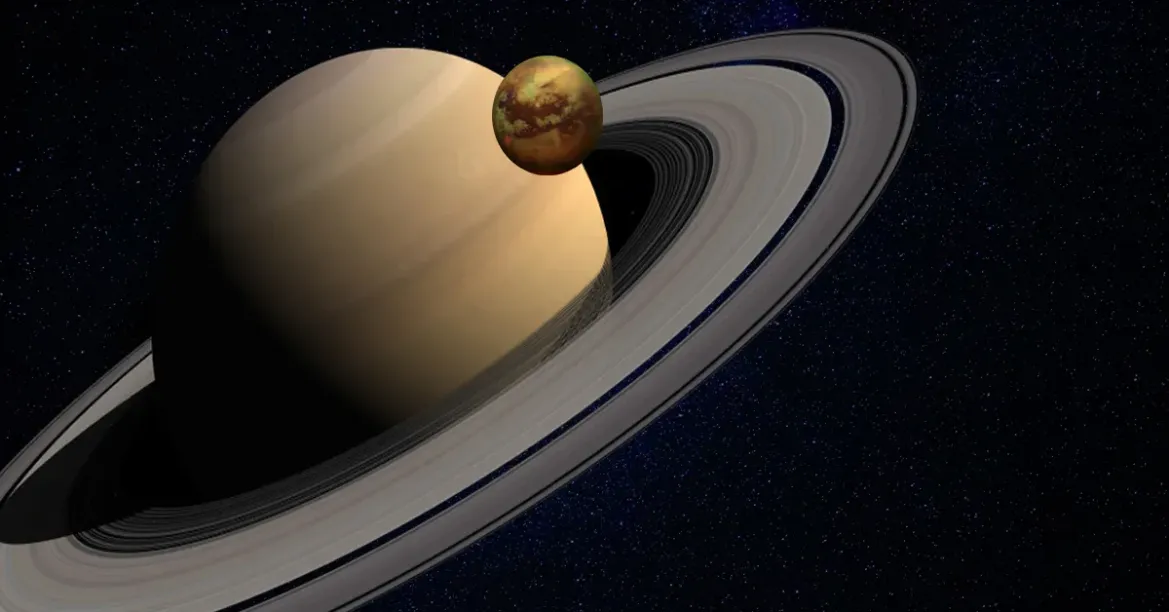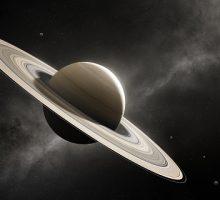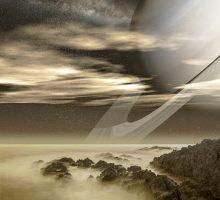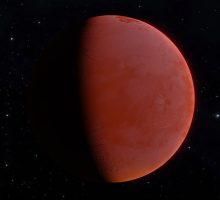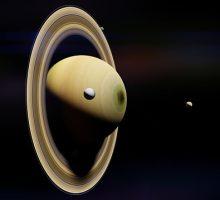- The mysteries of Titan: Exploring Saturn’s largest moon
- The weather on Titan: Methane rain, winds and clouds
- Uncovering the secrets of Titan’s vast oceans
- Titan’s unique geology: Mountains, canyons, and dunes
- Titan’s atmosphere: A closer look at the thick orange haze
- Life on Titan: Is it possible?
- The Cassini mission to Titan: A breakthrough in planetary exploration
- Titan’s hydrocarbon cycle: Understanding the moon’s complex chemistry
- Titan’s magnetic field: How does it compare to Earth‘s?
- Titan in popular culture: From science fiction to reality.
The mysteries of Titan: Exploring Saturn‘s largest moon
Exploring Saturn’s largest moon, Titan, is a fascinating adventure. Titan is the only moon in our solar system with a thick atmosphere, and it’s the second-largest moon in the solar system after Jupiter’s Ganymede. This moon is unique in many ways and has fascinated scientists for decades.
One of the greatest mysteries of Titan is the presence of liquid on its surface. Unlike Earth, where water is the main liquid on the surface, Titan has rivers, lakes, and seas of liquid methane and ethane. These hydrocarbons are essential components of Titan’s atmosphere, and scientists believe that they play a critical role in the moon’s climate.
Another mystery of Titan is its geology. The moon has an extensive system of canyons, mountains, and dunes that resemble features found on Earth. However, Titan’s landscape is also unique, with features that are unlike anything on our planet. For example, Titan has vast fields of sand dunes that are made of tiny grains of frozen hydrocarbons.
The atmosphere of Titan is another enigma that scientists are trying to unravel. Titan’s thick orange haze makes it difficult to observe the surface from space. However, spacecraft like the Cassini-Huygens mission have given us a glimpse of the moon’s surface. The atmosphere of Titan is primarily composed of nitrogen, with small amounts of methane and other gases. The haze is created when sunlight breaks down methane molecules, which then recombine into complex hydrocarbons that form the orange haze.
The search for life on Titan is another fascinating aspect of exploring the moon. Although Titan’s surface is too cold for life as we know it, some scientists believe that life could exist in the subsurface oceans of liquid water that may exist beneath the icy crust.
The weather on Titan: Methane rain, winds and clouds
Titan, Saturn‘s largest moon, has a unique weather system that is vastly different from any other body in our solar system. The weather on Titan is dominated by hydrocarbons, with liquid methane and ethane raining from the sky, winds blowing across the surface, and clouds drifting through the thick orange haze.
Methane rain is one of the most striking features of Titan’s weather. Instead of water, Titan’s rain is composed of liquid methane, which falls from the sky in large droplets. The rain forms in the upper atmosphere, where methane molecules are broken down by sunlight and recombine into larger hydrocarbons. These droplets then fall to the surface, creating rivers, lakes, and seas of liquid methane and ethane.
Winds on Titan are also significant, with gusts of up to 400 kilometers per hour observed by the Cassini-Huygens mission. These winds are thought to be caused by the differences in temperature between the equator and poles, with warm air rising at the equator and cold air sinking at the poles. The winds move sand dunes across the surface and create waves on the lakes and seas of liquid hydrocarbons.
Clouds on Titan are another unique feature of its weather. The clouds are composed of methane and ethane, and they form in the upper atmosphere. These clouds can be observed from space, and scientists have used them to study the dynamics of Titan’s atmosphere. The clouds can also indicate areas of active weather, such as storms or areas of heavy rainfall.
The weather on Titan is fascinating, and it offers scientists a unique opportunity to study the effects of hydrocarbons on a planetary scale. Understanding the weather on Titan can also provide insights into the early history of our solar system, as Titan’s weather system may be similar to the conditions that existed on Earth billions of years ago.
Uncovering the secrets of Titan’s vast oceans
Titan, the largest moon of Saturn, is an intriguing celestial object in our solar system. Among its many fascinating features are the vast oceans that cover much of its surface. These oceans, composed of liquid methane and ethane, have captivated the attention of scientists who are eager to uncover their secrets.
The discovery of the oceans on Titan was a major breakthrough in planetary science. In 2004, the Cassini-Huygens mission captured images of dark, smooth areas on the surface of Titan, which were later confirmed to be large bodies of liquid hydrocarbons. Since then, scientists have been studying these oceans to learn more about their composition, depth, and potential for life.
One of the most intriguing questions about Titan’s oceans is their depth. Scientists have used data from the Cassini mission to estimate that the largest sea on Titan, Kraken Mare, is up to 160 meters deep. This is much deeper than many scientists had initially anticipated, and it raises questions about the underlying geology of Titan.
Another mystery surrounding Titan’s oceans is their composition. While it is known that they are primarily composed of methane and ethane, there may be other compounds present as well. Some scientists have suggested that the oceans may contain small amounts of nitrogen, carbon dioxide, and other volatile compounds.
The potential for life in Titan’s oceans is another topic of great interest to scientists. While the extreme cold and lack of sunlight on the surface of Titan make it unlikely that life as we know it could exist, some scientists believe that there may be a possibility of life in the subsurface oceans. These oceans could potentially provide a habitat for microbial life, which could have evolved to survive in the extreme conditions of Titan’s environment.
Titan’s unique geology: Mountains, canyons, and dunes
Titan, the largest moon of Saturn, has a unique geology that sets it apart from any other celestial object in our solar system. From towering mountains and deep canyons to vast sand dunes, Titan’s landscape is a testament to the complex interplay between geological forces and atmospheric processes.
One of the most striking features of Titan’s geology is its mountains. The tallest peak on Titan, known as Doom Mons, stands over 3,000 meters tall and is located near the equator. These mountains are thought to be formed by tectonic activity, as the icy crust of Titan is compressed and pushed up by forces deep within the moon’s interior.
Another notable feature of Titan’s geology is its canyons. The largest canyon on Titan, known as Vid Flumina, is over 400 kilometers long and up to 20 kilometers wide. These canyons are thought to have been formed by a combination of tectonic activity and erosion by liquid hydrocarbons, which have carved deep channels into the moon’s icy surface.
Sand dunes are another prominent feature of Titan’s landscape. Unlike sand dunes on Earth, which are made of silica, the dunes on Titan are composed of hydrocarbon particles. These dunes are thought to be formed by wind, which blows across the surface of Titan and moves the hydrocarbon particles into large, complex structures that can stretch for hundreds of kilometers.
Titan’s unique geology is not only fascinating in its own right, but it also provides important insights into the history and evolution of our solar system. By studying the forces that have shaped Titan’s landscape, scientists can better understand the processes that have shaped other planetary bodies, including our own planet.
Titan’s atmosphere: A closer look at the thick orange haze
Titan, the largest moon of Saturn, is known for its thick, orange-colored atmosphere. This dense atmosphere is composed primarily of nitrogen, with smaller amounts of methane and other gases, and it plays a crucial role in shaping Titan’s unique environment.
One of the most striking features of Titan’s atmosphere is its thick haze. This haze, which is made up of complex organic molecules, is responsible for the orange color of the sky on Titan. The haze is so thick that it obscures much of the surface of the moon, making it difficult to study using traditional imaging techniques.
Despite the challenges posed by the haze, scientists have made significant strides in understanding the composition and behavior of Titan’s atmosphere. One important finding is that the atmosphere contains a significant amount of methane, which is constantly being broken down by sunlight and other forms of radiation. This breakdown process produces a variety of organic compounds, some of which are thought to be the building blocks of life.
The thick atmosphere of Titan also plays an important role in the moon’s climate. Unlike Earth, where the atmosphere is relatively thin and the climate is largely regulated by the oceans, the thick atmosphere of Titan traps heat and helps to regulate the temperature on the surface. This has led to the formation of complex weather patterns, including methane rain, winds, and even seasonal changes.
In addition to its importance for understanding the climate and environment of Titan, the study of the moon’s atmosphere has broader implications for our understanding of the formation and evolution of planetary systems. By studying the composition and behavior of Titan’s atmosphere, scientists can better understand the processes that have shaped the evolution of our own planet and other celestial objects in our solar system.
Life on Titan: Is it possible?
Titan, the largest moon of Saturn, is a fascinating place that has captured the imagination of scientists and space enthusiasts alike. With its thick atmosphere, vast oceans, and complex geology, Titan has been the subject of much speculation about the possibility of life on this distant moon.
While the harsh conditions on Titan, including extreme cold and the absence of liquid water, make the prospect of life on the moon seem unlikely, scientists have not ruled out the possibility entirely. One promising area of study is the complex organic chemistry that takes place in Titan’s atmosphere, which produces a wide range of organic compounds that are thought to be the building blocks of life.
Another area of interest is the liquid hydrocarbons that make up the lakes and seas on Titan’s surface. While these liquids are not water, they do provide a potential habitat for life forms that have evolved to thrive in environments that are drastically different from those on Earth.
Despite these promising areas of study, there are also significant challenges to the possibility of life on Titan. The extreme cold, lack of sunlight, and harsh radiation environment all present significant obstacles to the development and sustenance of life on the moon.
Nevertheless, scientists are continuing to explore the potential for life on Titan, both through remote sensing and through future missions to the moon. The upcoming Dragonfly mission, scheduled to launch in 2026, will send a drone to explore the surface of Titan and study the potential for life in the moon’s lakes and seas.
The Cassini mission to Titan: A breakthrough in planetary exploration
The Cassini mission to Titan, launched in 1997 and reaching Saturn’s largest moon in 2004, was a breakthrough in planetary exploration. Over the course of its thirteen-year mission, Cassini provided an unprecedented view of Titan’s environment, atmosphere, and surface.
One of the most exciting discoveries made by the Cassini mission was the presence of liquid hydrocarbons on the surface of Titan. This discovery challenged our previous assumptions about the possible environments in our solar system that could support liquid, and opened up a new realm of possibilities for planetary exploration and the search for life beyond Earth.
Cassini also provided valuable insights into the complex chemistry that takes place in Titan’s atmosphere. By studying the composition of the moon’s atmosphere and the behavior of its organic molecules, scientists gained a better understanding of the processes that shape the evolution of planets and moons throughout our solar system.
In addition to its scientific discoveries, the Cassini mission was also notable for its use of innovative technology and engineering. The Huygens probe, which was released from Cassini and descended to the surface of Titan, was the first spacecraft to successfully land on a moon in the outer solar system. The success of the Huygens probe and the Cassini mission as a whole have paved the way for future missions to explore the outer reaches of our solar system and beyond.
Despite the end of the Cassini mission in 2017, the data and discoveries made by the spacecraft continue to provide valuable insights into the complex and fascinating environment of Titan. As we look to the future of planetary exploration, the lessons learned from the Cassini mission and the ongoing study of Titan will undoubtedly play a crucial role in shaping our understanding of the solar system and the universe beyond.
Titan’s hydrocarbon cycle: Understanding the moon’s complex chemistry
Titan, Saturn‘s largest moon, is a unique and intriguing world with a complex and fascinating hydrocarbon cycle. This cycle, which involves the movement of methane and other hydrocarbons between the atmosphere, surface, and subsurface of the moon, has captured the attention of scientists for decades.
One of the key drivers of Titan’s hydrocarbon cycle is the moon’s thick atmosphere, which is rich in methane and other organic compounds. These compounds are continually broken down and reassembled by the energy from the sun and other sources, leading to the creation of a wide range of complex molecules.
As these molecules build up in the atmosphere, they eventually condense and fall to the surface as rain, forming rivers, lakes, and seas of liquid methane and ethane. These bodies of liquid, which cover much of Titan’s surface, are thought to be part of a continuous cycle of evaporation, precipitation, and flow that is similar to the water cycle on Earth.
The hydrocarbon cycle on Titan is also linked to the moon’s subsurface, where scientists believe that liquid hydrocarbons may exist in underground reservoirs. These reservoirs may interact with the surface and atmosphere of Titan through a complex system of geological processes, including volcanic activity, tectonic movements, and erosion.
Studying the hydrocarbon cycle on Titan is a challenging but essential task for scientists who seek to understand the evolution and potential habitability of this fascinating moon. By exploring the interactions between the atmosphere, surface, and subsurface of Titan, researchers hope to gain insights into the complex chemistry that takes place in extreme environments, and ultimately to shed light on the origin and evolution of life in our solar system and beyond.
Titan’s magnetic field: How does it compare to Earth‘s?
Titan, Saturn’s largest moon, is a unique and intriguing world with many fascinating features, including a magnetic field. While Titan’s magnetic field is much weaker than Earth‘s, it is still an important and interesting phenomenon that scientists have been studying for many years.
Earth‘s magnetic field is generated by the motion of molten iron in its core, which creates a powerful magnetic field that extends far beyond the planet’s surface. This field helps to protect Earth from harmful solar radiation and cosmic rays, and also plays a crucial role in the planet’s climate and weather.
Titan’s magnetic field, on the other hand, is thought to be generated by a different process. While the moon does have a core of molten rock and metal, it is not thought to be active enough to create a significant magnetic field. Instead, scientists believe that Titan’s magnetic field is generated by the interaction between the moon’s atmosphere and the magnetic field of Saturn, its parent planet.
This interaction creates a small magnetic field around Titan, which has been measured and studied by spacecraft such as the Cassini mission. While this field is much weaker than Earth‘s, it still plays an important role in shaping the environment of Titan and the behavior of its atmosphere.
Studying the magnetic field of Titan is an important task for scientists who seek to understand the complex interactions between planets and moons in our solar system. By exploring the similarities and differences between Titan’s magnetic field and Earth‘s, researchers can gain valuable insights into the evolution of planetary systems and the factors that influence the habitability of worlds beyond our own.
Titan in popular culture: From science fiction to reality.
Titan, Saturn’s largest moon, has captured the imagination of scientists and the public alike for many years. With its unique environment, complex chemistry, and potential for habitability, this moon has become a popular subject of science fiction and a target for scientific exploration.
One of the earliest references to Titan in popular culture can be found in the works of the French astronomer and author Camille Flammarion, who wrote about the possibility of life on the moon in the late 19th century. Since then, Titan has appeared in numerous science fiction novels, movies, and TV shows, often as a setting for exotic alien landscapes and mysterious creatures.
In recent years, Titan has also become a target for real-world scientific exploration. The Cassini mission, which explored Saturn and its moons from 2004 to 2017, provided valuable insights into the composition and behavior of Titan’s atmosphere and surface. More recently, NASA’s Dragonfly mission, scheduled to launch in 2027, will send a drone to explore Titan’s surface in detail, including its potential for habitability.
As scientific knowledge of Titan continues to grow, so too does its influence on popular culture. From the imaginative worlds of science fiction to the real-world challenges of space exploration, this moon has become a symbol of human curiosity and ingenuity, inspiring generations to push the boundaries of what is possible.
Whether we are exploring the mysteries of Titan’s chemistry and geology or imagining the possibilities of life on its surface, there is no doubt that this moon will continue to captivate and inspire us for many years to come. As we look to the future of space exploration and scientific discovery, Titan will undoubtedly play a key role in our quest to understand the universe and our place within it.

